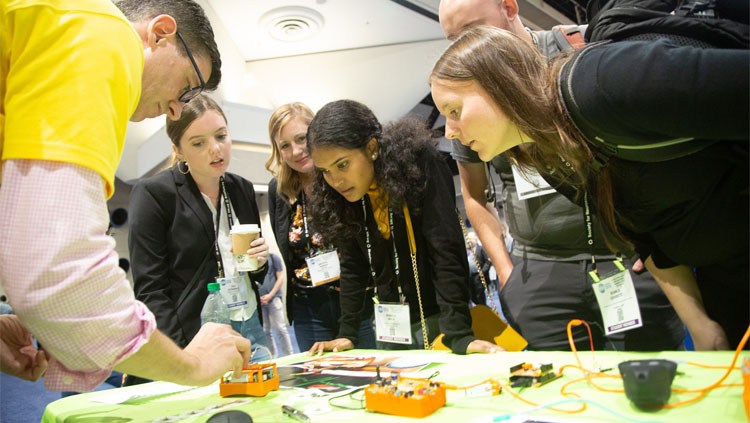
Hosting a booth at a conference or other event can be a great way to raise brain awareness, connect with people with interests similar to yours, and encourage others to get involved in their community.
When preparing to exhibit at a public event, it’s important to start planning early. With careful preparation and organization, you can ensure your outreach is a success.
Follow the steps below to help you plan for and run a booth that gets people talking about the brain.
1. Purchase Booth Space
Some events require you to purchase the booth almost a year in advance in order to reserve your spot. Start by determining the cost of the booth, keeping in mind you’ll usually need to pay upfront for at least a portion if not all of it to hold your space. Decide what size booth you’ll need, which can vary depending on how many materials you plan to bring and how many staff or volunteer members will work the booth with you. Most booths measure 10 square feet (a single booth) or 10x20 feet (a double booth).
2. Order What You’ll Need
While some events provide tables, chairs, wastebaskets, and carpeting for exhibitors, others do not. Find out what will be supplied for you and then order the rest. If you’ll need electricity to run any of your activities, let the event organizer know you want to order it. Lead retrievals may also be available and can be used to scan attendees’ badges for following up after the event. For large events, there is usually a show company that will ship your materials to and from the event. Determine if there is a separate company, and if so, ask them for an estimated shipping cost.
3. Decide What to Bring
About 2–3 months in advance, start thinking about the types of materials or activities you’ll have and how many of each you’ll need. Consider the audience who will be in attendance. For example, if the event is for kids, bring plenty of games so they can try them. In contrast, if mostly adults will be at the event, just a sample or two of your materials may be sufficient.
4. Promote Your Booth
Don’t forget to get the word out! With all of the work you’ve put into planning your booth, this step is crucial for letting interested audiences know you’ll be at the event. Social media can allow you to reach many people at once. Post several times in the months leading up to the event, using attractive images and engaging text to capture people’s attention. Tease what you’ll be bringing and what attendees can learn, and show you’re excited to be going, too!
5. Recruit Help
At this time, you’ll also want to figure out how many people from your organization will help run the booth. The more activities you plan to have on site, the more people will need to be there. Ideally, at least one person would be assigned to an individual activity. If you’re in need of additional help, social media can also be an ideal place to find volunteers outside of your organization. Additionally, you can search the Find a Neuroscientist database on BrainFacts.org to reach out to scientists who are interested in outreach and located in the city in which the event will take place.
6. Register for the Event
About a month before the event, you should know which staff and/or volunteers will exhibit with you. Many conferences require preregistration of these people, so be mindful of any deadlines. Then, create a packing list, ask another person to look over it, and leave plenty of time to pack — it can often take longer than expected.
7. Set Up and Run Your Booth
Most conferences designate time for exhibitors to set up their booth before the conference formally begins. Take advantage of this time to design your display so it’s visually appealing and inviting to attendees who may be walking by. If you meet people during the event you want to connect with again, take their business card and make a note for yourself about what they do or what you discussed to help you remember. After the event, return any materials you ordered, and if you scanned badges, send a follow-up email to those who stopped by your booth and may want to learn more about your topic.
This guide was prepared by SfN outreach staff. Visit BrainFacts.org to learn more or reach out to baw@sfn.org with questions.







